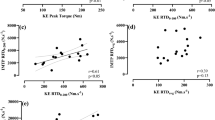Abstract
The loss of the ability of skeletal muscle to generate force is one of the most appropriate and valid means to quantify muscle damage. Routine measurements of maximal muscle force, however, include many potential sources of error, the most important of which may be a possible lack of central drive to the muscles. The aim of the present study was to determine the reliability of maximal isometric quadriceps muscle force and voluntary activation over a timescale that is typically employed to examine the aetiology of exercise-induced muscle damage. We also attempted to characterise the reliability of several twitch interpolation variables including the size of the interpolated twitch and the state (i.e. unpotentiated vs potentiated) and size of the resting twitch. Over a 7-day period, eight healthy active males performed repeated maximal voluntary isometric contractions (MVC) of the quadriceps (baseline and 2 h, 6 h, 24 h, 48 h, 72 h and 7 days post). Systematic variations in maximal muscle force, voluntary activation, interpolated twitch, unpotentiated twitch and potentiated twitch were not statistically significant (P>0.05) and 95% repeatability coefficients of ±76.03 N, ±4.42%, ± 8.44 N, ±25.92 N and ±43.58 N were observed, respectively. These data indicate that young healthy well-familiarised male subjects can reproduce their perceived maximal efforts both within and between days where activation levels of >90% are routinely achieved. Providing activation remains within these limits in the 7 days following an acute bout of exercise, the researcher would be 95% certain that exercise-induced muscle damage is present in individual subjects (taken from similar subject populations) if MVC force falls outside these limits.





Similar content being viewed by others
References
Atkinson G, Nevill AM (1998) Statistical methods for assessing measurement error (reliability) in variables relevant to sports medicine. Sports Med 26:217–238
Behm DG, St-Pierre DMM, Perez D (1996) Muscle inactivation: assessment of interpolated twitch technique. J Appl Physiol 81: 2267–2273
Behm D, Power K, Drinkwater E (2001) Comparison of interpolation and central activation ratios as measures of muscle inactivation. Muscle Nerve 24:925–934
Behm DG, Whittle J, Button D, Power K (2002) Intermuscle differences in activation. Muscle Nerve 25:236–243
Bland JM, Altman DG (1999) Measuring agreement in method comparison studies. Stat Methods Med Res 8:135–160
Bulow PM, Norregaard J, Danneskiod-Samsoe B, Mehlsen J (1993) Twitch interpolation technique in testing of maximal muscle strength: influence of potentiation, force level, stimulus intensity and preload. Eur J Appl Physiol 67:462–466
Byrne C, Twist C, Eston R (2004) Neuromuscular function after exercise-induced muscle damage. Sports Med 34:49–69
Faulkner JA, Brooks SV (1997) Muscle damage induced by contraction. In: Salmons S (ed) Muscle damage. Oxford University Press, Oxford, pp 28–40
Faulkner JA, Brooks SV, Opiteck JA (1993) Injury to skeletal muscle fibres during contractions: conditions of occurrence and prevention. Phys Ther 73:911–921
Gandevia SC (2001) Spinal and supraspinal factors in human muscle fatigue. Physiol Rev 81:1725–1789
Gollnick PD, Armstrong RB, Saltin B, Saubert CW, Sembrowich WL, Shepherd RE (1973) Effect of training on enzyme capacity and fibre composition of human skeletal muscle. J Appl Physiol 34 107–111
Graven-Neilsen T, Lund H, Arendt-Neilsen L, Danneskiold-Sansoe B, Bliddal H (2002) Inhibition of maximal voluntary contraction by experimental muscle pain: a centrally mediated mechanism. Muscle Nerve 26:708–712
Henneman E, Clamann HP, Gilles JD, Skinner RD (1974) Rank order of motoneurons within a pool: law of combination. J Neurophysiol 37: 1338–1348
Kent- Braun JA, Le Blanc R (1996) Quantification of central activation failure during maximal voluntary contraction in humans. Muscle Nerve 19:861–869
Keogh JWL, Wilson GJ, Weatherby RP (1999) A cross-sectional comparison of different resistance training techniques in the bench press. J Strength Cond Res 13:247–258
Knight CA, Kamen G (2001) Adaptations in muscular activation of the knee extensor muscles with strength training in young and older adults. J Electromyogr Kinesiol 11:405–412
McArdle A, Jackson MJ (1999) Mechanisms of muscle damage with injectable products. In: Gupta PK, Brazeau GA (eds) Injectable drug development. Interpharm Press, Englewood, pp 57–77
Merton PA (1954) Voluntary strength and fatigue. J Physiol (Lond) 123: 553–564
Millet GY, Lepers R (2004) Alterations of neuromuscular function after prolonged running, cycling and skiing exercises. Sports Med 34: 105–116
Nevill AM, Atkinson G (1997) Assessing agreement between measurements recorded on a ratio scale in sports medicine and sports science. Br J Sports Med 31:314–318
Nevill AM, Atkinson G (1998) Assessing measurement agreement (repeatability) between 3 or more trials. J Sports Sci 16:29
Newman SA, Jones G, Newham DJ (2003) Quadriceps voluntary activation at different joint angles measured by two stimulation techniques. Eur J Appl Physiol 89:496–499
Norregaard J, Lykkegaard JJ, Bulow PM, Danneskiod-Samsoe B (1997) The twitch interpolation technique for the estimation of true quadriceps muscle strength. Clin Physiol 17:523–532
Oskouei MAE, van Mazijk BCF, Schuiling MHC, Hezrog W (2003) Variability in the interpolated twitch torque for maximal and sub-maximal voluntary contractions. J Appl Physiol 95:1648–1655
Rutherford OM, Jones DA, Newham DJ (1986) Clinical and experimental application of the percutaneous twitch superimposition technique for the study of human muscle activation. J Neurol Neurosurg Psychiatry 49: 1288–1291
Shield A, Zhou S (2004) Assessing voluntary muscle activation with the twitch interpolation technique. Sports Med 34:253–267
Surter E, Herzog W, Huber A (1996) Extent of motor unit activation in the quadriceps muscles of healthy subjects. Muscle Nerve 19:1046–1048
Todd G, Gorman RB, Gandevia SC (2004) Measurement and reproducibility of strength and voluntary activation of lower limb muscles. Muscle Nerve 29:834–842
Warren GL, Lowe DA, Armstrong RB (1999) Measurement tools used in the study of eccentric contraction-induced injury. Sports Med 27:43–59
Acknowledgements
We are grateful to Professor David Jones, Professor Simon Gandevia and Dr Walter Herzog for helpful comments regarding the experimental set-up and discussions of the findings.
Author information
Authors and Affiliations
Corresponding author
Rights and permissions
About this article
Cite this article
Morton, J.P., Atkinson, G., MacLaren, D.P. et al. Reliability of maximal muscle force and voluntary activation as markers of exercise-induced muscle damage. Eur J Appl Physiol 94, 541–548 (2005). https://doi.org/10.1007/s00421-005-1373-9
Accepted:
Published:
Issue Date:
DOI: https://doi.org/10.1007/s00421-005-1373-9




